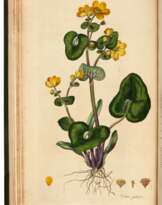William Curtis | Flora Londinensis. London, 1777-1828, an important survey of London flora
28.11.2023 14:00UTC +00:00
Classic
Verkauft
6985GBP £ 6 985
| Auctioneer | Sotheby´s |
|---|---|
| Veranstaltungsort | Vereinigtes Königreich, London |
Archiv
Die Auktion ist abgeschlossen. Es können keine Gebote mehr abgegeben werden.

ID 1073316
Los 27 | William Curtis | Flora Londinensis. London, 1777-1828, an important survey of London flora
Schätzwert
£ 7 000 – 10 000
Flora Londinensis; or, plates and descriptions of such plants as grow wild in the environs of London. [with] William Jackson Hooker. Flora londinensis; containing a history of the plants indigenous to Great Britain. London: Printed for and Sold by the Author, at his Botanic-Garden, 1777, 1798; Printed for George Graves, 1819-1828
FIRST EDITION, 4 volumes, folio (490 x 295mm.), dedication to the Earl of Bute, list of subscribers, eight-leaf manuscript “General Index” and “English Index” inserted following preface in vol. 1, 648 hand-coloured engraved plates, volumes 1-3 in fine early twentieth-century green morocco gilt, volume 4 in recent matching (slightly darker) green morocco gilt, without the printed general indexes and two articles called for by Henrey. title of first volume carefully backed and a little soiled, preliminary leaves unevenly trimmed at bottom, preface leaf with crease flattened and minor tear repaired, text leaves with overall very light browning (plates, with a few exceptions, brighter), a dozen leaves with moisture stain at fore-edge
Although various parts and editions of the Flora Londinensis appear regularly in the marketplace, the present item is a rare combination of this celebrated botanical work, comprised of the first editions of both William Curtis’ original issues, published in 72 numbers appearing between 1775 and 1798, and Sir William Jackson Hooker’s continuation
of the work, published between 1817 and 1828. It is unique in its arrangement, as a former owner with expertise in botany combined the plates from Curtis and Hooker, arranging the plates by type of plant, rather than binding them as issued in the original fascicles. In creating this personalized copy, he discarded the printed index issued with each fascicle, hand-numbered the plates according to his system of arrangement, and wrote out his own general index, using both Latin and English names, in an elegant hand.
William Curtis (1746-1799) is one of the great names in natural history, and his Flora Londinensis (along with his famous Botanical Magazine) is a landmark in English botany. A pharmacist, botanist, and entomologist, Curtis set up a botanic garden of British plants at Bermondsey in 1771 and two years later was appointed demonstrator of plants at the Chelsea Physic Garden, a post he held until 1777. Although the stated purpose of the Flora Londinensis is to depict the plants growing within a ten-mile radius of London, the work is much more comprehensive in scope than its title suggests, for it embraces most of the flowers growing in England. As a result, it should be properly regarded as the first colour-plate national flora. It is an impressive work with handsome engraved illustrations and wonderfully rich colouring. In Henrey’s words, “Curtis adopted the novel plan of having specimens drawn to a uniform scale and to life size, and most of the plates display a high degree of accuracy. In the opinion of [Sir J.E.] Salisbury, the majority of the figures ‘represent the most successful portrayals of British wild flowers that have ever been achieved.’” (II, 67) Described by the Hunt catalogue as the “splendid, complicated, basic, English flora,” the work contains some of James Sowerby’s first botanical illustrations as well as the work of William Kilburn, Sydenham Edwards, Francis Sansom, and perhaps others (none of the plates are signed).
Unfortunately, the Flora Londinensis was not a financial success and consequently was cut short for lack of subscriptions: according to Henrey’s account, no more than 300 of any single number are believed to have been printed. Although the work’s comprehensive nature means that quite a number of images record plants that are not visually arresting, they all are beautifully coloured. The bindings here are a special bonus: the design is elegantly handsome, the execution is impeccable, and the exactitude of the replication done for the fourth binding is remarkable.
| Künstler: | William Curtis (1746 - 1799) |
|---|---|
| Kategorie des Auktionshauses: | Drucke, Graphik, Bücher |
| Künstler: | William Curtis (1746 - 1799) |
|---|---|
| Kategorie des Auktionshauses: | Drucke, Graphik, Bücher |
| Adresse der Versteigerung |
Sotheby´s 34-35 New Bond Street W1A 2AA London Vereinigtes Königreich | |
|---|---|---|
| Vorschau |
| |
| Telefon | +44 (0) 20 7293 5000 | |
| Telefon | +1 212 606 7000 | |
| Nutzungsbedingungen | Nutzungsbedingungen |





![The Botanical Magazine [with Index and Companion], London, 1793-1948, 130 vols, green morocco gilt](/assets/image/picture_3101204/2529a/kttnqj7lasri0qflt7of0wprv0ysua3g3r-cnmsequ3ao6cutjddqptzzjysw7w1693990866jpg__fix_162_205.jpeg)

